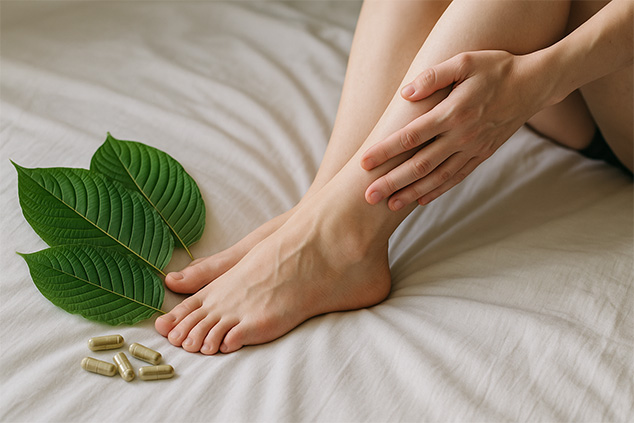RLS is a common condition that, on its own, may not be dangerous. Yet, if left untreated, it can lead to serious health issues. Sadly, there isn’t a cue or an effective treatment method that doesn’t have a myriad of side effects. Therefore, a growing number of people seek alternative treatment methods such as kratom for restless leg syndrome.
What Is the Restless Leg Syndrome?
Restless leg syndrome, also known as RLS, Willis-Ekbom Disease, or WED, is a neurological disorder. It causes uncomfortable sensations in the legs, which results in an irresistible urge to move one’s legs to relieve it.
It’s most commonly experienced in the late afternoon, evening, or during the night when a person is relaxed and trying to sleep. As a result, restless leg syndrome affects sleep, causes fatigue, and daytime sleepiness.
In the long term, untreated RLS can lead to sleep deprivation resulting in other health conditions, such as depression and anxiety. It can also affect one’s mood and ability to concentrate, leading to decreased work or school performance as well as affecting relationships. Travelling also can be challenging.
An estimated 7-10% of Americans suffer from restless leg syndrome, with women being twice more susceptible to it. While it’s possible to develop the disorder at any age, symptoms become more frequent and longer-lasting with age. So, middle-aged and older people have a much harder time.
The exact cause of the condition is not known. However, some individuals may be more genetically predisposed to it, especially if it runs in their family. Certain conditions such as iron deficiency and neurological damage may lead to it as well.
Restless Leg Syndrome Symptoms
The intensity and frequency of RLS symptoms can vary from person to person. However, in moderate cases, they occur once or twice per week, and more than twice a week in more severe cases.
Sometimes, there may also be remission periods. When the condition first develops, these can last weeks or even months, but usually become more consistent and frequent as the condition progresses.
People with RLS experience the following:
- Unpleasant sensations in the legs such as aching, itching, throbbing, pulling, or crawling that affect one or both legs, and sometimes, though rarely, the arms and the chest. These can range in intensity from irritating to painful. Therefore, people with RLS tend to pace, move leg when sitting, or toss and turn in bed to rid of the uncomfortable sensations.
- Difficulty falling and staying asleep. Restless leg syndrome symptoms are worse in the evening and during the night.
- Daytime sleepiness and fatigue.
In addition to RLS, about 80% of those who have the disorder also develop a condition called PLMD or periodic limb movement disorder. This condition causes legs and sometimes arms to involuntarily jerk or twitch during sleep. This occurs periodically every 15-40 seconds during the non-REM stages of sleep. During REM sleep, the body loses its muscle tone, so a person with RLS does not experience PLMD then.
Common RLS Treatment Methods
Currently, there is no cure for restless leg syndrome. However, certain treatment options can alleviate the symptoms and help a person with RLS get adequate rest and sleep.
Most frequently, RLS patients are recommended to adopt lifestyle changes or natural treatment methods. These can be:
- Reducing alcohol and tobacco consumption
- Regulating or changing sleep patterns
- Exercise, yoga, or stretching routines or programs
- Leg massage
- Acupuncture
- Warm baths
- Foot wraps
- Vibration pads
- Pneumatic compression which resembles a sleeve that inflates and deflates similarly to a blood pressure meter, providing gentle pressure on the affected limbs
- Applying ice packs or heating pads
These include:
- Iron supplements – these are usually prescribed to those RLS patients with low iron levels or iron deficiency,
- Anti-seizure drugs – for moderate to severe RLS cases,
- Dopaminergic agents – long-term use of these, however, can worsen RLS symptoms,
- Opioids – doctors may prescribe these for more severe cases that do not respond to other treatment,
- Benzodiazepines –due to the side effects associated with this type of medication, they can be prescribed as last resort if no other medication is effective.

Can Kratom Relieve RLS?
Sadly, many of the medications that doctors may prescribe, such as dopaminergic agents, opioids, and benzodiazepines, can worsen RLS symptoms or have other side effects. Therefore, people who suffer from RLS, especially in more severe stages of it, may seek alternative relief methods.
People who’ve taken kratom for restless leg syndrome have found powerful relief in the herb. Some refer to it as a miracle cure or Holy Grail of RLS, others with restless leg syndrome state that kratom has given them their life back.
Since there are different types of kratom, they can provide support for RLS in a variety of ways, such as by helping to relax in the evening and improve sleep quality as well as by providing energy and focus during the day.
Which Type of Kratom Is Best for RLS (Restless Leg Syndrome)?
Red vein kratom for restless leg syndrome can be helpful during the late afternoon, evening, as well as during the night. It can help to relax, ease stress and anxiety, boost mood, and relieve pain.
Red strains tend to improve the mood and help one fall asleep. They also tend to have a long duration and can help one stay asleep and get proper rest.
Some red vein strains of kratom you can try for restless leg syndrome are Red Bali, Red Borneo, Red Thai, and Red Maeng Da kratom.
Green vein kratom for restless leg syndrome can also be beneficial. Since greens are moderate strains, they are not sedative as red vein kratom strains. Instead, they provide mind pain relief and relaxation as well as mood and energy boost and improved focus. So, greens are best taken in the morning or early afternoon.
Green vein kratom for restless leg syndrome you can try is Green Maeng Da, Green Malay, Green Horn Kratom, and Green Kali.
Yellow kratom isn’t a natural strain, but rather a blend of other vein types. Its properties are moderate and similar to those of green vein kratom. Therefore they can be beneficial if you need extra support to get through your day.
Yellow Bali is a popular and affordable strain and can be helpful if you are looking for daytime kratom for restless leg syndrome relief.
In most cases, it’s best to avoid white vein kratom if you have restless leg syndrome. While beneficial for getting a strong energy boost, while vein kratom is taken in small doses. Taking too much can make one restless and jittery, especially if they are new to kratom or only have limited experience with the herb.
Can Kratom Cause Restless Leg Syndrome?
While not common, it is possible to experience temporary restless leg syndrome or to have your symptoms worsen if you are experiencing kratom withdrawal.
Even though many sources liken kratom withdrawal to that you can experience from opioids; it’s far from the truth. Kratom withdrawal is more akin to one you can experience after abruptly stopping drinking coffee. You may feel nauseous, irritable, and anxious, and your sleep quality may worsen too. As a result, your restless leg syndrome may become more intense.
Kratom withdrawal is not dangerous, but rather unpleasant. And it is possible to avoid it if you take kratom responsibly.
Keep in mind that you should measure your kratom dose each time. This will ensure that you won’t accidentally increase your dose and up your kratom tolerance. The best way of making a reset and treating kratom tolerance is by taking a break. This can result in a withdrawal.
In addition to measuring your dose, you should also rotate kratom strains. This involves taking different strains at different times or alternating strains. For instance, you may take Green Maeng Da during the day and Red Borneo before sleep. Or you may take Red Bali one day and Red Borneo the next.
Lastly, purchase kratom from a reputable, trusted vendor. Buying from shady vendors can result in your kratom being inconsistent in potency and quality. You may end up unknowingly upping your tolerance. There is also a risk of it being contaminated or adulterated, and the substances laced with kratom can also worsen your condition.
Always measuring your dose, rotate your strains, and make sure that your kratom comes from a trusted vendor.
Have you taken kratom for restless leg syndrome? How did it go? Which strains are your preferred ones for this condition?



Leave a Reply